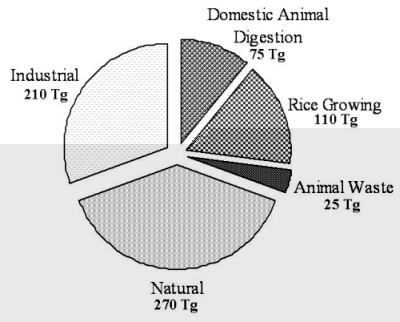

Figure Set 2: Methane Emissions from Agriculture
Cognitive Skills: (see Bloom's Taxonomy) - Knowledge, Interpretation
FIGURE SET
Table 2. This table was constructed using data from the Intergovernmental Panel on Climate Change (IPCC) report in 2007. Information is shown regarding two important greenhouse gases, Carbon Dioxide (CO2) and Methane (CH4). Atmospheric concentration data are reported as parts per million (ppm) in the atmosphere, while the % increase indicates the change in ppm for each gas between pre-industrial and present time points.
| Carbon Dioxide (CO2) | Methane (CH4) | |
Atmospheric concentration |
(ppm)* | (ppm) |
| Pre-industrial | 280 | 0.8 |
| Present (2005) | 379 | 1.77 |
| % Increase | 36% | 121% |
Atmospheric lifetime (years) |
50-200 | 12 |
Relative radiative effectiveness |
||
| Per unit mass over 100 years | 1 | 25 |
* ppm: parts per million | ||

Figure 2a. This figure shows total global production of methane per year divided into five categories. Units are in teragrams (Tg), which is equivalent to 1012 grams. A total of 690 Tg of methane are emitted to the atmosphere each year. Agricultural processes (i.e., domestic animal digestion, rice growing, animal waste) produce 210 Tg of methane, which is 30% of total methane emissions and 50% of anthropogenic methane emissions. Natural processes in soil and the atmosphere convert this methane to carbon dioxide by oxidizing the carbon, but 84 Tg of methane do not get oxidized every year and remain in the atmosphere. This imbalance between methane emissions and oxidation has resulted in a 121% increase in atmospheric methane concentrations since pre-industrial times. Figure 2a was drawn from data in Figure 1 in Moss et al. (2000), which is published in the journal 'Annales de Zootechnie.